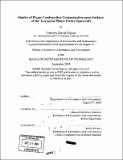Studies of plume condensation contamination upon surfaces of the Terrestrial Planet Finder spacecraft
Author(s)
Pigeon, Timothy David
DownloadFull printable version (8.081Mb)
Other Contributors
Massachusetts Institute of Technology. Dept. of Aeronautics and Astronautics.
Advisor
Manuel Martínez-Sánchez.
Terms of use
Metadata
Show full item recordAbstract
There are two competing concepts for the Terrestrial Planet Finder (TPF) mission, one which involves a single spacecraft, and another comprised of a five craft formation. In addition, there are several propulsion options under consideration. Unique contamination issues affect the formation-flying concept due to the close proximity of the spacecrafts. Select surfaces must be maintained at the low temperature of 40 K. There is concern that propellant expelled from one craft will condense on the cryogenic surfaces of a neighboring craft, adversely affecting performance and the integrity of the observational data. The condensation properties of warm Xenon, Krypton, and Argon upon a cryogenically-chilled QCM were characterized at a range of temperatures and pressures. Heats of adsorption were predicted with a model to solve for intermolecular forces, and experimental data was used to assess the model's validity. Knowledge of the heat of adsorption was used to determine the equilibrium level of surface coverage for both a pulsed and constant operation thruster, for a range of impinging gas fluxes. The model aims to aid in the selection of an appropriate propulsion system and propellant for the TPF spacecraft.
Description
Thesis (S.M.)--Massachusetts Institute of Technology, Dept. of Aeronautics and Astronautics, 2005. Includes bibliographical references (leaves 81-82).
Date issued
2005Department
Massachusetts Institute of Technology. Department of Aeronautics and AstronauticsPublisher
Massachusetts Institute of Technology
Keywords
Aeronautics and Astronautics.